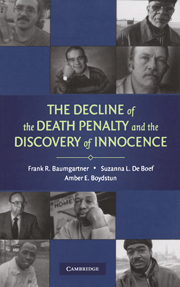Book contents
- Frontmatter
- Contents
- List of Tables
- List of Figures
- Acknowledgments
- 1 Innocence and the Death Penalty Debate
- 2 The Death Penalty in America
- 3 A Chronology of Innocence
- 4 The Shifting Terms of Debate
- 5 Innocence, Resonance, and Old Arguments Made New Again
- 6 Public Opinion
- 7 The Rise and Fall of a Public Policy
- 8 Conclusion
- Epilogue: Individuals Exonerated from Death Row
- Appendix A New York Times capital punishment coverage, 1960 to 2005
- Appendix B Description of Data
- Notes
- References
- Index
Appendix A - New York Times capital punishment coverage, 1960 to 2005
Published online by Cambridge University Press: 05 September 2012
- Frontmatter
- Contents
- List of Tables
- List of Figures
- Acknowledgments
- 1 Innocence and the Death Penalty Debate
- 2 The Death Penalty in America
- 3 A Chronology of Innocence
- 4 The Shifting Terms of Debate
- 5 Innocence, Resonance, and Old Arguments Made New Again
- 6 Public Opinion
- 7 The Rise and Fall of a Public Policy
- 8 Conclusion
- Epilogue: Individuals Exonerated from Death Row
- Appendix A New York Times capital punishment coverage, 1960 to 2005
- Appendix B Description of Data
- Notes
- References
- Index
Summary
The aim of this data collection project was to track media framing of capital punishment over time. To accomplish this task, we collected and coded paper copies of all abstracts of articles on the death penalty as listed under the heading “capital punishment” in the New York Times Index for the years 1960 through 2005, a total of 3,939 abstracts. Two coders (Feeley and Boydstun) worked independently to code the bulk of this data (1960 to 2002), with intercoder reliability of approximately 98 percent at the first level of coding (seven main categories plus one “other” category) and 92 percent at the second level of coding (sixty-five distinct arguments). One of these coders (Boydstun) then worked alone to update the dataset through 2005.
We assigned each abstract one and only one code to capture the overall tone (i.e., pro–death penalty, anti–death penalty, or neutral) as well as one and only one code for the type of article being summarized (i.e., news, editorial, op-ed, or letter to the editor). Additionally, we coded each abstract according to its component arguments, whether it mentioned victim and/or defendant characteristics, and any characteristics of the crime. The same abstract could receive multiple codes for those variables. Finally, we coded each abstract for the presence of any of sixty-five distinct arguments about the death penalty – pro–death penalty arguments, anti–death penalty arguments, and neutral arguments – as described below.
- Type
- Chapter
- Information
- The Decline of the Death Penalty and the Discovery of Innocence , pp. 243 - 251Publisher: Cambridge University PressPrint publication year: 2008



